Nowadays, the SysOps workspace mainly takes place in the cloud. This makes the tech infrastructure extremely scalable. A system administrator no longer needs to manage physical servers and hard drives, but encrypts servers, hard drives and databases in the cloud. On the other hand, you have developers who are concerned with building applications. The moment an application goes live, it is often no longer as simple as 'just uploading'. That application has to communicate with a complicated online infrastructure. As a result, you increasingly need a SysOps engineer who understands the infrastructure and a developer who understands the application. They will then make a deployment together.
DevOps: the bridge between development and operations
In the gray area between architecture and infrastructure, we know how to reap the benefits in the right places. All thanks to our extensive experience with DevOps.

The combination of developers and system operators
Joining forces
‘Development’ + ‘Operations’ = DevOps
The (better) alternative is one DevOps engineer, who understands both. The moment you want to improve something in your application, a SysOps engineer will (by default) try to solve it with the infrastructure, when that might not be the best choice. At the same time a developer will try to solve it in his application, while that may not be the best choice. If you have someone who is experienced in DevOps - who therefore has sufficient knowledge of both domains to know what the possibilities are of the gray area in the middle - you can justify those choices much better. One person can then, for example, make a deployment automation, because they know enough about the application and know enough about the infrastructure to be able to tackle that entire area.

The advantages of DevOps
Safe and efficient custom software development
When DevOps is not taken into account, things can sometimes go wrong in the transition from the development environment to the live version of an application. This takes time and often results in a lot of frustration. Automating all these processes through DevOps prevents this and fits seamlessly with our vision behind continuous development. Just think of the frustrations you can save yourself! But that's not all; new functionalities can be delivered at lightning speed and adjustments can be made without entailing enormous risks.
Curious about the DevOps techniques of 10KB?
A sneak peek: Docker, Kubernetes & GitLab
We're not going to give away all of our secrets, of course, but indispensable DevOps tools as far as we're concerned are Docker and Kubernetes. Developing in containers allows us to adapt individual components without affecting the rest of the application. And thanks to a watertight GitLab version control system that seamlessly connects to Kubernetes, these adjustments can also be tested and implemented very quickly.
To make everything run even smoother, our DevOps experts use AWS (Amazon Web Services). This popular service provides ready-to-use software packages and relieves you of the laborious task of configuring the server. This service, in combination with linting tools such as Flog, Flay and ESLint, ensures that we can quickly deliver new, well-functioning features that are immediately ready for use.
